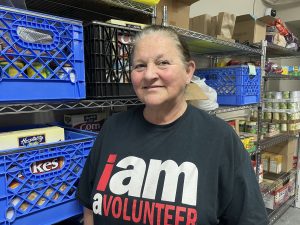GULF COAST HIT AGAIN
by Karen Gleason –
Hurricane Katrina relief photos by Ron Londen–Journey Group. |
SEPTEMBER 26, 2005—With a personality all her own, Katrina’s little sister Rita has allowed The Salvation Army to reacquaint itself with some of its crucial history.
It was after the great Galveston hurricane and flood of 1900—still the nation’s deadliest natural disaster—that the Army provided its first disaster relief services in the U.S.
Today, 105 years later, Hurricane Rita again brought an early focus of hurricane relief on the island of Galveston. Fortunately, the island received only minor damage and no deaths; however, the same cannot be said for other regions of the Gulf Coast. While only seven deaths have so far been attributed directly to Rita, the combined damage from Hurricanes Katrina and Rita will require massive rebuilding and a long-term commitment by The Salvation Army to the people of the Gulf Coast.
In a statement to New Frontier on The Salvation Army’s commitment to the victims of these storms, John Berglund, national disaster services coordinator, said: “A crisis affects the entire body, not just one part or another. Katrina and Rita demand the attention of The Salvation Army worldwide, not just one department, one division, or even one territory. The national emergency management paradigm has shifted under our feet, as mass evacuation and long-term sheltering become a reality in the United States.
“It is always Disaster Services, the muscle of The Salvation Army, that’s first on the front lines, supported by the CRD [Community Relations and Development], ARC [adult rehabilitation centers], and Social Services departments. Together, without departmental walls, is how The Salvation Army will do the most good.”
Thus, working together, this is an Army that can be deployed to a number of fields simultaneously, to meet varying needs. With relief efforts continuing after Hurricane Katrina, the Army prepared for Hurricane Rita, calling in personnel and resources from its four U.S. territories and beyond. Shelters were opened, and canteens and kitchen units were brought in and prepared—along with volunteers to staff them.
“Before the storms come, during the storms and well after the storms have gone, The Salvation Army is prepared and ready to respond with meals, water, shelter and personnel trained to help people and communities,” said Major George Hood, the Army’s national community relations and development secretary.
While some questioned the nation’s ability to deal with two major hurricanes in rapid succession, the Army remained assured that, with God’s help, it could meet the challenge.
“It’s really beefing up versus stretching resources,” said Kelly Warner, the Army’s public relations and marketing director for the Texas Division. She explained that although about 50 percent of the Army’s mobile feeding units are in Louisiana, “we’re not going to pull them out because they’re still in desperate need there.” Instead, reinforcements are arriving from other areas of the U.S. and Canada, including a mobile kitchen from New York that can produce 5,000 meals a day.
Before Rita hit, as more than a million residents fled the Texas Gulf Coast, the Army heeded the call of Harris County officials to help provide water to evacuees stuck on the highway. Working in shifts, volunteers provided more than 160,000 bottles of water to stranded motorists.
During and after the storm, assessments were made in conjunction with other disaster relief agencies regarding the deployment of Army resources. While Galveston and Houston escaped the feared devastation, other areas were hard hit, particularly the “Golden Triangle” of Beaumont, Port Arthur and Orange, and many small towns of 1,000-5,000 people. The Army does not neglect these towns, sometimes forgotten by the press, as it spreads out its resources to include them.
As of this writing, 17 canteens are operating in the area out of three large mobile kitchens, with nine more canteens expected shortly. Sunday 25 September was a day of partial service as the Army mobilized, and Monday 26 September was the first full day of service.
Along with meeting the victims’ immediate needs, The Salvation Army is helping victims find long-term relief. In one example, in partnership with Good Morning America (GMA), the Army is helping the small town of Pass Christian, Mississippi. As the town’s needs are assessed, the Army could find itself helping out in a number of ways. For more information, see the GMA website: https://abcnews.go.com/GMA/ under “Contests, Ballots & More.”
Photo by Ron Londen–Journey Group











